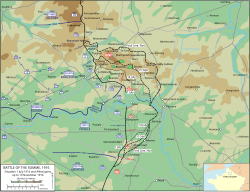| Battle of Albert (1916) | |||||||
|---|---|---|---|---|---|---|---|
| Part of the Battle of the Somme | |||||||
 | |||||||
| |||||||
| Belligerents | |||||||
|
|
| ||||||
| Commanders and leaders | |||||||
|
Joseph Joffre Douglas Haig Ferdinand Foch Henry Rawlinson Marie Émile Fayolle Hubert Gough Edmund Allenby |
Erich von Falkenhayn Fritz von Below Fritz von Loßberg Günther von Pannewitz | ||||||
| Strength | |||||||
|
13 British divisions 11 French divisions | 6 divisions | ||||||
| Casualties and losses | |||||||
|
British, 1 July: 57,470 2–13 July: 25,000 French, 1 July: 1,590 2–21 July: 17,600 |
1 July: 10,200 1–10 July: 40,187–46,315 | ||||||
The Battle of Albert (1–13 July 1916) is the British name for the first two weeks of British–French offensive operations of the Battle of the Somme. The Allied preparatory artillery bombardment commenced on 24 June and the British–French infantry attacked on 1 July, on the south bank from Foucaucourt to the Somme and from the Somme north to Gommecourt, 2 mi (3.2 km) beyond Serre. The French Sixth Army and the right wing of the British Fourth Army inflicted a considerable defeat on the German 2nd Army but from near the Albert–Bapaume road to Gommecourt, the British attack was a disaster, where most of the c. 57,000 British casualties of the day were incurred. Against the wishes of General Joseph Joffre, General Sir Douglas Haig abandoned the offensive north of the road to reinforce the success in the south, where the British–French forces pressed forward through several intermediate lines closer to the German second position.
The French Sixth Army advanced across the Flaucourt plateau south of the Somme and reached Flaucourt village by the evening of 3 July, taking Belloy-en-Santerre and Feullières on 4 July. The French also pierced the German third line opposite Péronne at La Maisonette and Biaches by the evening of 10 July. German reinforcements were then able to slow the French advance and defeat attacks on Barleux. On the north bank, XX Corps was ordered to consolidate the ground captured on 1 July, except for the completion of the advance to the first objective at Hem next to the river, which was captured on 5 July. Some minor attacks took place and German counter-attacks at Hem on 6 to 7 July nearly retook the village. A German attack at Bois Favières delayed a joint British–French attack from Hardecourt to Trônes Wood by 24 hours until 8 July.
British attacks south of the road between Albert and Bapaume began on 2 July, despite congested supply routes to the French XX Corps and the three British corps in the area. La Boisselle near the road was captured on 4 July, Bernafay and Caterpillar woods were occupied from 3 to 4 July and then fighting to capture Trônes Wood, Mametz Wood and Contalmaison took place until early on 14 July, when the Battle of Bazentin Ridge (14–17 July) began. German reinforcements reaching the Somme front were thrown into the defensive battle as soon as they arrived and had many casualties, as did the British attackers. Both sides were reduced to piecemeal operations, which were hurried, poorly organised and sent troops unfamiliar with the ground into action with inadequate reconnaissance. Attacks were poorly supported by artillery-fire, which was not adequately co-ordinated with the infantry and sometimes fired on ground occupied by friendly troops. Much criticism has been made of the British attacks as uncoordinated, tactically crude and wasteful of manpower, which gave the Germans an opportunity to concentrate their inferior resources on narrow fronts.
The loss of about 57,000 British casualties in one day was never repeated but from 2 to 13 July, the British had about 25,000 more casualties; the rate of loss changed from about 60,000 to 2,083 per day. From 1 to 10 July, the Germans had 40,187 casualties against a British total of about 85,000 from 1 to 13 July. The effect of the battle on the defenders has received less attention in English-language writing. The strain imposed by the British attacks after 1 July and the French advance on the south bank led General Fritz von Below to issue an order of the day on 3 July, forbidding voluntary withdrawals ("The enemy should have to carve his way over heaps of corpses.") after Falkenhayn had sacked Generalmajor Paul Grünert, the 2nd Army Chief of Staff and General der Infanterie Günther von Pannewitz, the commander of XVII Corps, for ordering the corps to withdraw to the third position close to Péronne. The German offensive at Verdun had already been reduced on 24 June to conserve manpower and ammunition; after the failure to capture Fort Souville at Verdun on 12 July, Falkenhayn ordered a "strict defensive" and the transfer of more troops and artillery to the Somme front, which was the first strategic effect of the British–French offensive.